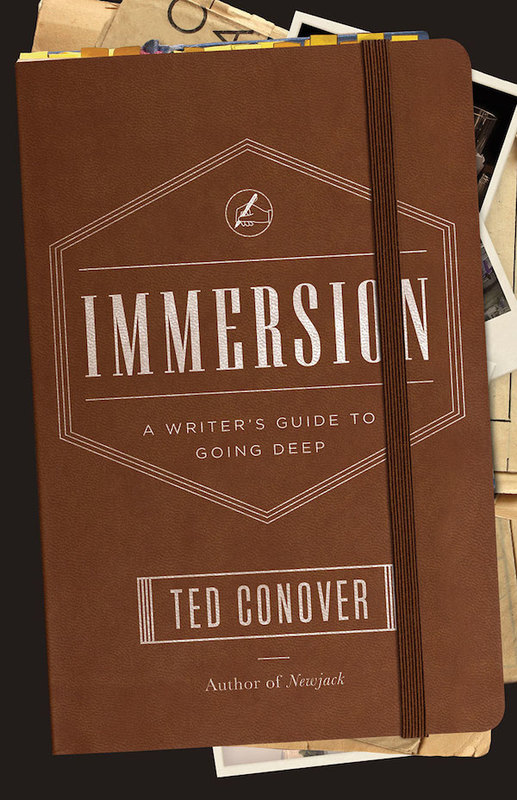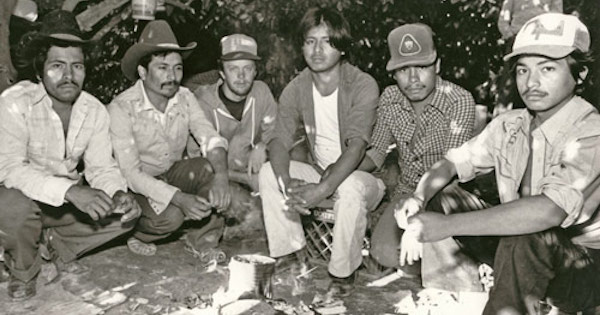During a career that’s spanned three and a half decades, Ted Conover has guarded hardened criminals in Sing Sing, snuck across the US border with Mexican immigrants, inspected poultry as a USDA employee, and roamed the nation as a railroad hobo–all in pursuit of his next big story.
Along the way, he’s become one of the prominent practitioners of immersion writing, steeping himself in other worlds that are typically off-limits to reporters and the public.
For some books and articles, Conover’s gone undercover. For others, he’s left home to live among disenfranchised subjects. In his new book Immersion: A Writer’s Guide to Going Deep, Conover distills decades of hard-won knowledge into a how-to guide for journalists.
Among his topics: how to gain access to new communities, how to behave ethically once inside, and how to craft a powerful story when it’s all over. The following interview was conducted over email during November 2016, and has been edited for length and clarity.
You write that Immersion is the book you wish you’d had with you when you were 22 years old, immersing yourself in the world of railroad tramps. At the time, you were researching your college thesis, which later morphed into your first book, Rolling Nowhere: Riding the Rails with America’s Hoboes. What inspired you to finally commit these techniques and advice to paper? What was the spark? And how long had the idea for Immersion been gestating?
Immersion is just one of the ways I’ve researched stories. All of my books before this one are based on it, but I’ve never thought of it as a separate class of research. I know that other people have, though. One of them was an editor at the University of Chicago Press (Jenny Gavacs) who suggested to me that I write this book.
With the nation bitterly divided following Donald Trump’s election–and lots of hand wringing in the mainstream press over having misread the mood of the electorate–what role, if any, do you think immersion writing can play in bridging the cultural divides in this country? And how might immersive projects help address those aforementioned reportorial blind spots?
I think that immersion research makes it harder to think of any group of people simplistically. No part of the electorate is merely “angry.” “Less educated” also seems like an unhelpful descriptor, unless maybe it’s paired with some words and phrases that haven’t commonly been used to describe Trump supporters, such as “disadvantaged” or “at risk of going broke.” I write that “immersion implies leaving home–or at least spending significant amounts of time outside it–engaged in daily exposure to your subjects and the problems they face. Writing that proceeds from this can answer complaints about the superficiality of journalism. It offers cures on several levels, one of which is the level of commitment. Immersion tells the reader: This is no drive-by. I did more than get a quote. I lingered and I listened. I got to know them as multidimensional.”
In your experience, what part of the immersion process do young writers and journalists struggle most with? Is there a common point at which newer practitioners of the craft hit a wall? What’s the hardest part of the process for you, personally?
I’d say that access is often the hardest for younger journalists–it can be a real challenge getting people to “let you in,” particularly if you’re not on assignment from some recognizable news source and don’t yet have a track record. Next hardest may be what I call reporting for story: learning what to look for, the kind of notes your research needs to generate (i.e., characters, conflicts, the passage of time, and other elements of narrative).
Access is a perpetual problem for me as well, particularly since I’m interested in setting a high bar, in trying to do things that haven’t been done before.
Technology is transforming the way we gather information and tell stories. How is it affecting immersive writing, specifically? Has it changed the way you and your peers and/or students working in the genre operate?
Well, I don’t think the essential tools have changed: you need a pen and a notebook. You need to be able to listen and you need to be able to explain yourself. You need to notice.
But technology definitely has expanded the number of possibilities for telling these stories, in ways which really haven’t been fully explored yet. Back when only wealthier, tech-savvy people had smart phones, you had to worry about taking out your smart phone in certain settings. Now, though, it seems practically everybody in the US has one–I was in a Starbucks in Denver last week where two homeless men were charging their phones. A third had taken his laptop from his cart and was using the store’s Wifi. This is great, because adding video and still photography to our reports can expand the audience, the options for telling a story, and the richness of the story itself. And, of course, it can help empower people who previously were only the subjects of our stories to tell stories of themselves.
You write of students sometimes wanting to dive directly into immersion writing, without first mastering the tenets of traditional journalism or third-person nonfiction storytelling. What is the ideal training for a writer before they embark on an immersive project?
I do think it’s helpful to know the basics of journalism before you set out–conventions around quotation, using anecdotes to help illustrate a larger theme, the importance of topicality, that sort of thing. Immersion research can take a long time, and experience in turning reporting into story can help insure that time won’t be wasted.

Ted Conover is author of Immersion: A Writer’s Guide to Going Deep, and an associated professor of journalism at New York University. His other books include Newjack: Guarding Sing Sing; Rolling Nowhere: Riding the Rails with America’s Hoboes; and Coyotes: A Journey Across Borders with America’s Mexican Migrants.
If there’s one book of immersive writing you could recommend to a young journalist, what would it be and why?
I think the most important book or article is one you love, the one that speaks to you. Such a book for me is Stanley Booth’s brilliant Dance with the Devil: The Rolling Stones and Their Times. (I wrote an appreciation of it in CJR in 2006.) It’s full of joyful literary risk-taking. But it’s also a cautionary tale about what can happen when you get too close to the flame, when you go too deep.
Finding models is super-important in this endeavor, which is one reason I assembled a detailed bibliography at the end of Immersion. Each of those books and articles, to me, is a possible inspiration.
The time commitment for immersive projects can be huge. How can a writer know they’ve found a worthwhile story?
I guess it’s like the commitment a writer makes to any big story. It needs to be about something that matters, a topic you might be able to make readers care about, and one you’re likely to care about for the time it takes. You need a fairly good prospect of ongoing access; having a Plan B in place should that access fall apart is not a bad idea. It can help to have friends who don’t think the idea is crazy, and even better is to have an agent or editor who’s intrigued.
In the paperback afterword to Newjack, you wrote of having nightmares related to your experience working as a correction officer at Sing Sing–dreams a psychiatrist suggested were the result of Post-Traumatic Stress Disorder. (Full disclosure: I received a diagnosis of PTSD after reporting my book on a Bloods/Crips gang war in New York, and your mention of PTSD in the afterword was one of the things that encouraged me to seek treatment in the first place.) Do you consider dealing with mental health issues to be an unavoidable hazard of immersion work?
I’m glad you raised the possibility that research can take a toll on the researcher. PTSD among journalists is real, and not just for war reporters and photographers. Immersion is probably not the best approach for a journalist who is not feeling pretty centered and stable to begin with. The trick then becomes how to maintain your equilibrium should conditions become stressful. Having a wife I love, who believed in my project, really helped me endure the months I spent working as a CO. And having little kids at home, though they at times contributed to my exhaustion, I’m sure ultimately helped keep me steady. With projects that are less emotionally fraught, like my stint as a USDA meat inspector, the main challenge can simply be managing feelings of isolation and loneliness. Again, having somebody waiting for you at home can be indispensable.
You write that immersion writing has “huge potential for sowing empathy in the world,” and that an immersion writer “cannot help but come to appreciate the other’s point of view, hopefully in a way that is both visceral and nuanced.” Newjack sowed empathy for both corrections officers and prisoners. What lessons/insights from that book would you want to impart on journalists covering the American corrections system today, and the ongoing efforts to reform it?
Acknowledge the pain on both sides. Don’t demonize the civil servants. All of us are actors in systems that make us behave in certain ways. The challenge is to reform the system.
The amount of media available to American consumers has grown exponentially in recent years. But immersion writing seems to always find its audience. What can immersion writing do that other forms of storytelling can’t? Why does it endure?
I think its power comes from how quickly it can lead a reader to the emotional core of a story. Immersion writing is almost never dry. It’s also as personal as its creators, which is to say every good project seems to invent its own trajectory. As a genre it has been with us for a long time, at least as far back as Sir Richard Burton’s excursions to Arabia in the mid-19th century; and yet every season seems to bring us another example of somebody adventurous opening a window into a world we realize we’ve never seen before.

Conover paused for a photo with migrants while reporting for his book Coyotes: A Journey Across Borders with America’s Mexican Migrants.
Can you point out some of the best immersion journalism you’ve seen recently?
I admire Jennifer Percy’s Demon Camp: A Soldier’s Exorcism, an up-close, lyrical depiction of PTSD; Suki Kim’s Without You, There Is No Us, about teaching English in North Korea; Matthew Desmond’s Evicted; and Shane Bauer’s undercover account of working in a private prison in Mother Jones.
Here are some other significant works of immersion writing Conover highlights in his book:
Nickel and Dimed by Barbara Ehrenreich
Among Schoolchildren by Tracy Kidder
The Spirit Catches You and You Fall Down by Anne Fadiman
Among the Thugs by Bill Buford
Behind the Beautiful Forevers by Katherine Boo
Holy Days by Lis Harris
Collision Low Crossers by Nicholas Dawidoff
Methland by Nick Reding
Mississippi Drift by Matthew Power
My Enemy, My Self by Yoram Binur
Kevin Deutsch is an award-winning criminal justice journalist and author of two books: The Triangle: A Year on the Ground with New York’s Bloods and Crips, and the forthcoming Pill City: How Two Honor Roll Students Foiled the Feds and Built a Drug Empire, to be published Jan. 31. He teaches journalism at Queens College.

